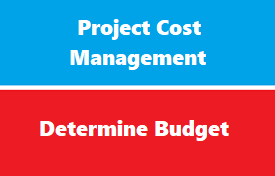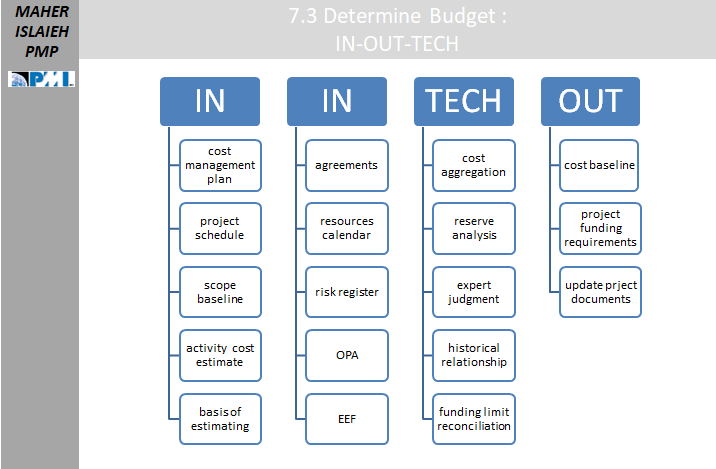introduction
Determine Budget is the process of aggregating the estimated costs of individual activities or work packages to establish an authorized cost baseline.
The key benefit of this process is that it determines the cost baseline against which project performance can be monitored and controlled. The inputs,
How to create budget ?
to create budget :
- activity estimate
- work packages estimate >>work package is set of activities
- control account estimate (main sub leaf of WBS )
- project estimate (set of WBS )
- contingency reserve (KNOWN risk from perform quantitative risk analysis )
- cost baseline (sum of project estimate + contingency reserve )
- management reserve (UNKONWN risk , set by management as percentage of cost baseline )
- cost budget (sum cost baseline + management reserve )
Consideration points
Some Point to be considered when create budget :
- cost baseline is formal and approved version of time-phased project budget , it contains project budget but without management reserve, and any change to cost baseline should be approved by change control board CCB through Integrated change control ICC
- funding limit re-conciliation
- the estimated value should be near to committed project value at first , otherwise ,, we have to re-estimate until to get true value estimating
- after aggregate (cost budget ) , then project manager should check (cash flow as part of funding limit reconciliation )
- funding maybe NOT available when its need , which could change other part of project
- the project manage should perform another re-conciliation before proposed cost baseline and cost budget become final
- if estimation (set by project manager) , exceed project constraints (that set at project charter ), then project manager should have a meeting with top management to explain why their constraints (at project charter ) could NOT be net . and try to find another option to decrease cost
determine budget inputs- techniques - outputs
Inputs
- cost management plan
- project schedule
- scope baseline
- activity cost estimate
- basis of estimating
- agreements
- resources calendar
- risk register
- OPA
- EEF
Techniques
- cost aggregation
- reserve analysis
- expert judgment
- historical relationship
- funding limit reconciliation
Outputs
- cost baseline
- project funding requirements
- update project documents
determine budget inputs
Project Management Plan
The components of the overall project management plan that will be inputs to this process are:
1- Cost management plan
- an output of process 7.1 Plan Cost Management, this gives guidelines on bow to do all of the other planning processes, including this one.
2- Resources management plan
- this provides information on the cost of resources which are needed to estimate the overall project budget.
3- Scope baseline:
- Project scope statement–breaks down the scope from the level of requirements discussed at the initiating process phase of the project, to the level of deliverables that fulfill those requirements
- WBS (Work Breakdown Structure)–breaks down the scope from the level of deliverables (found in the project scope statement) to the level of work packages
- WBS Dictionary–this contains information about the work packages related to other constraints (this will be updated with cost estimates as a result of this process)
Project Documents
Schedule Knowledge Area
- Basis of estimates–output of process 6.4 Estimate Activity Durations, this may contain assumptions related to the activities which may have a bearing on whether these costs should be included in the budget, particularly if they are indirect costs (costs not necessarily associated solely with the current project)
- Project schedule–output of process 6.5 Develop Schedule, contains planned start and finish dates for the activities and work packages, which may have a bearing on which calendar period these project costs are to be incurred in.
1- Cost Knowledge Area
- Cost estimates–As a result of process 7.2 Estimate Costs, cost estimates for each activity within a work package are aggregated to obtain a cost estimate for each work package,
2- Risk Knowledge Area
- Risk register–the risk register (an output of process 11.2 Identify Risks, and updated in every risk management planning process that follows it) contains information on costs for risk responses.
Business Documents
These are documents created in the initiating process phase, which are the outputs of processes done by business analysts.
- Business case–includes the financial success factors for the project
- Benefits management–what are the benefits of the project on an ongoing basis to the firm? The benefits management plan may include the target benefits, measured by net present value or return on investment, to give two examples.
Agreements
Agreements is the PMI code word for “contracts” between the company and vendors who are contributing resources to be used by the company to do the project, or products which will be incorporated as components of the project.
Enterprise Environmental Factors
- For large-scale projects that extend multiple years with multiple currencies, it may be necessary to refer to exchange rates, so that any fluctuations in those rates and be considered in the upcoming process 7.3 Develop Budget.
Organizational Process Assets
- Historical information and lessons learned repository from previous similar projects.
- Existing cost budgeting-related policies and guidelines.
- Cost budgeting tools
- Reporting methods (which stakeholders get reports, in what format, and how often)
determine budget techniques
all techniques for determine budget has been discussed previous article ( estimate cost)
determine budget : outputs
- In project management, the project managers need to know exactly what their funding requirements are, even before they commence with the project. There are two types of funding management requirement and these include the total funding requirement and the period requirement. The total funding requirement is defined as the cost that is identified in the cost baseline. It also includes the management reserves. The period funding requirement is defined as the annual and quarterly payments. Both of these funding requirements are derived from the cost baseline.
- The funding may occur in incremental amounts in project management. They might not also be evenly distributed. This particular project management document should also include the sources of the funding or where the funds will be obtained. It is one of the necessary inputs that is used creating the control costs that is necessary for monitoring and updating the project costs and its changes.
- The cost baseline is an important element in determining the project funding requirement and it includes the projected expenditures as well as the anticipated liabilities that may arise in the middle of the project.


